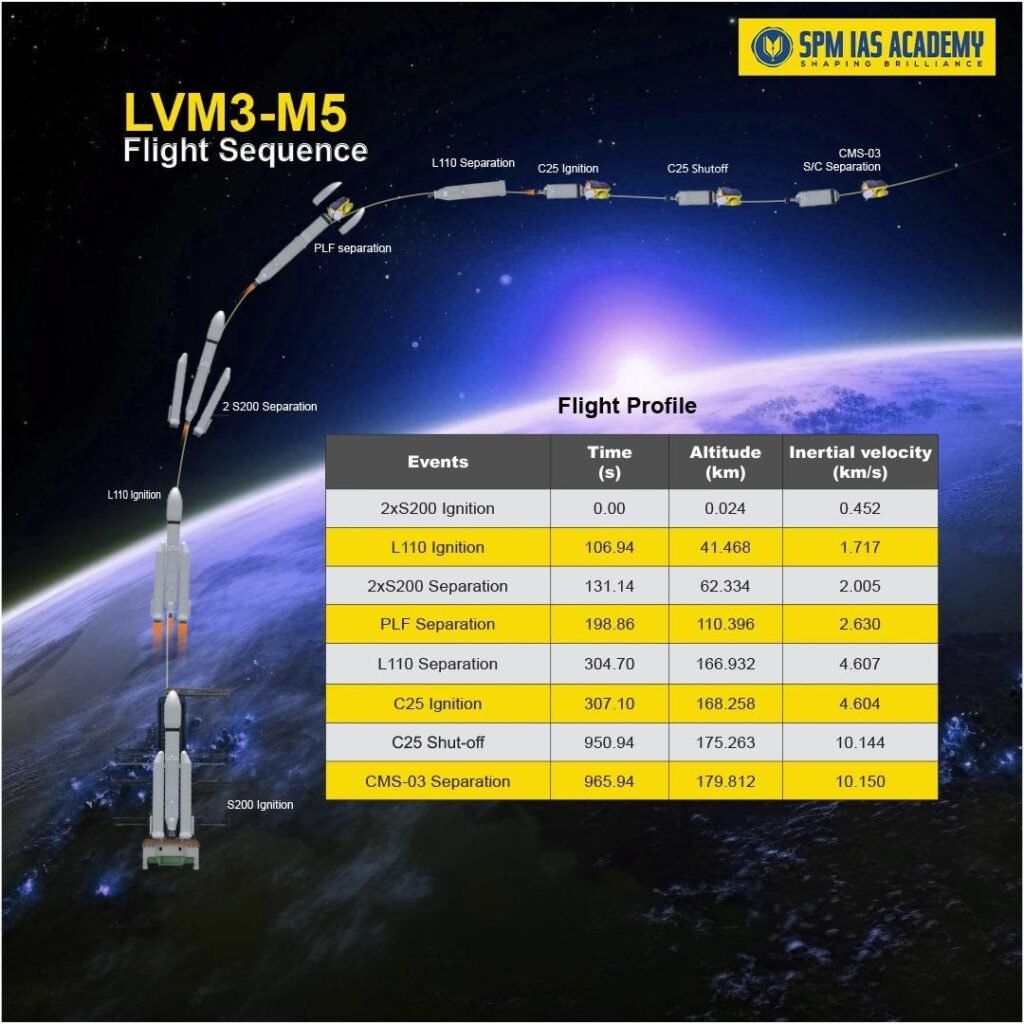From launching small satellites in the 1980s to deploying world-class communication systems, India’s CMS-03 launch marks a defining leap in the nation’s space journey — a true symbol of technological self-reliance and progress.
.
Why in the news?
- India’s LVM3 launch vehicle has successfully launched the CMS-03 communication satellite in its 5th operational flight (LVM3-M5) on November 02, 2025.
- So far, ISRO had to contract out the launch of its heavier satellites to private space agencies from other countries.
About the CMS-03 Satellite:
- CMS-03 is a multi-band communication satellite that will provide services over a wide oceanic region including the Indian landmass.
- CMS-03, weighing 4,410kg, is the heaviest communication satellite launched from Indian soil.
- It is to be placed in the Geosynchronous Transfer Orbit (GTO). It will be placed in a transfer orbit of around 29,970 km x170 km from the surface of the earth.
- ISRO used its biggest rocket LVM-3.
- GSAT-11 (weighing 5,800 kg) launched in 2018 was heavier than it. It used the European Ariane-5 rocket. ISRO had been relying on the European rocket for sending all its heavier satellites, weighing more than 3000 kg.
- Launch of CMS-03 is a demonstration of ISRO’s growing strategic autonomy and technological independence in executing complex missions.
- The satellite incorporates a host of new technologies and is a shining example of Atmanirbhar Bharat.
Purpose of CMS-03:
- It will serve the purposes of the India Navy, augmenting its space based communications and maritime domain awareness.
- Also known as GSAT-7R, CMS-03 is the replacement for GSAT-7 satellite launched in 2013 on Ariane-5 rocket. GSAT-7 has reached the end of its lifespan.
- GSAT-7R will provide robust telecommunication coverage across the Indian Ocean Region. Its payload includes transponders capable of supporting voice, data, video links over multiple communication bands.
- This satellite will significantly enhance connectivity with high capacity bandwidth, enabling seamless and secure communication links between ships, aircraft, submarines and Maritime Operations Centres of the Indian Navy.
- CMS-03 was designed to provide communication services for at least 15 years.

LVM-3 and its capacity:
- LVM3 is the new heavy lift launch vehicle of ISRO for achieving a 4000 kg spacecraft launching capability to GTO (Geosynchronous Transfer Orbit) in a cost effective manner.
- Earlier referred as Geosynchronous Launch Vehicle Mark 3 or GSLV Mk 3, it uses solid, liquid, as well as cryogenic fuel based engines to put up to 8,000 kg in low earth orbit (up to an altitude of 2,000 km from Earth’s surface) and up to 4,000 kg in geosynchronous orbit (about 36,000 km).
- GSLV Mk 3 rocket was adapted in 2022, amid the Russia-Ukraine war, to launch 72 OneWeb satellites in two launches to low earth orbit.
- Although, GSLV name meant to deposit satellites only to the geosynchronous orbit, but the OneWeb missions showed that this rocket could be used for other purposes as well.
- The current launch is a milestone towards the growing capability of the LVM3 rocket. ISRO will use its modified version in the Gaganyaan mission to put humans in space.
- The previous mission of LVM3 launched the Chandrayaan-3 mission, through which India became the first country to land successfully near the Lunar South Pole.
- With CMS-03, ISRO has demonstrated the heavy lift capability of the LVM3 rocket.
- LVM-3 will have a crucial role in India’s future missions, including Gaganyaan, or building of Bharatia Antariksh Station, which would involve sending very heavy payloads into space.
Sources:
- https://www.isro.gov.in/LVM3_M5_CMS_03_MISSION.html
- https://www.businesstoday.in/india/story/cms-03-launch-india-enters-new-space-era-as-isro-successfully-places-4410-kg-satellite-in-orbit-500505-2025-11-02
- https://indianexpress.com/article/explained/explained-sci-tech/heaviest-satellite-to-be-launched-from-india-10340866/
CMS-03 Satellite, also known as GSAT-7R, is a multi-band communication satellite developed by ISRO to enhance India’s maritime communication network. Weighing 4,410 kg, it is the heaviest communication satellite ever launched from Indian soil using the LVM3-M5 rocket.
The CMS-03 satellite launch marks India’s growing self-reliance in space technology. For the first time, ISRO launched such a heavy satellite using its own LVM3 rocket, without relying on foreign launch vehicles. It reflects India’s progress toward Atmanirbhar Bharat and strategic space autonomy.
CMS-03 satellite will primarily serve the Indian Navy, strengthening maritime communication and domain awareness across the Indian Ocean Region. It enables secure voice, data, and video links between ships, aircraft, submarines, and command centers, replacing the aging GSAT-7 satellite.
The Launch Vehicle Mark-3 (LVM3) is ISRO’s most powerful heavy-lift rocket, capable of carrying up to 4,000 kg to Geosynchronous Transfer Orbit (GTO). After launching Chandrayaan-3, LVM3 has now proven its operational reliability with CMS-03 and will play a key role in future missions like Gaganyaan and Bharatiya Antariksh Station.
By deploying CMS-03 satellite, India will secure indigenous satellite communication for naval and strategic operations. It enhances defence readiness, surveillance, and connectivity while demonstrating ISRO’s capacity to execute complex missions independently — a major boost for India’s space and defence synergy.












